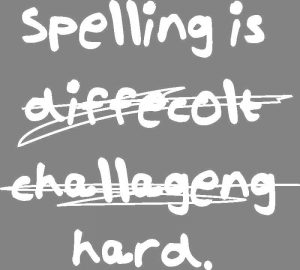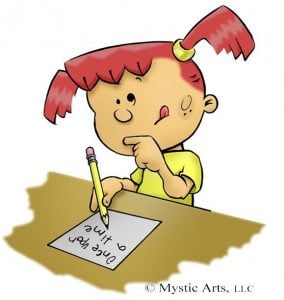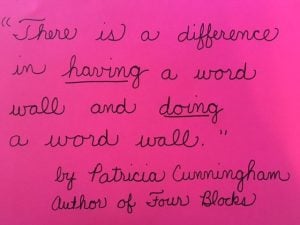by C. Elkins, OK Math and Reading Lady
Can u reed wut i am riting? Can u tel frum my riting that i no most uv the mane sonds in werds? I no sum site werds, i no the sonds in order frum left to rite as i strech them out. I no sum vowl paterns. I can evn spel sum 2 silubul werds by trying 1 silubul at a time. After i am dun riting, the teecher helps me pik out 2 werds to lern. Then i practis them a fu timez and add them to my speshul werd book so i can find and uz them agen.
This is an example of temporary spelling appropriate for a late KG-2nd grade student. The “student” was able to focus on the content of their writing using spelling strategies mentioned in my previous posts:
- Stretch out sounds or use sound boxes.
- Clap to hear the distinct syllables and spell each syllable separately.
- Think about spelling patterns from known or rhyming words.
- Use words posted on the word wall and/or in the individual word book.
- Try words different ways to see which one looks right.
For this student, I would have selected these 2 words (werd/word and frum/from) for further practice because they were used often, close to the correct spelling, and only need minor adjustments. I usually have them circle the words we chose. These words only need minor tweaking and they are likely to be words needed often for future writing. When the words are added to his/her word book, they are there for reference and are more likely to be used correctly in the future.
When young students are writing, there is a fine balance so students don’t feel correct spelling is the only goal. I want students to know writing is just “like talk written down.” You want the ideas to flow and their “voice” to come through in the writing. If too much emphasis is put on spelling, then the student hesitates to write and usually reverts to easy words and short sentences. So temporary spelling enables students to write more fluently, while at the same time show approximation so they and other readers can decipher it.
Before the word temporary spelling was introduced, the term inventive spelling was widely used. While the concept was basically intended to be the same, the term inventive gave the impression students were not using any kind of strategies – like they were just making things up without careful thought. Parents did not accept this either and got the idea students were indeed inventing ways to spell a word instead of working toward learning it. I think students and parents understand temporary — an attempt at spelling while working toward learning the correct accepted spelling. I tell young children (and parents): “I don’t expect you to know how to spell all of the words you want to write right now. But I do expect you to work on them gradually, via spelling, writing, and reading lessons. And in the meantime, I will teach you strategies for trying to spell words you don’t yet know.”
Temporary spelling is used by students as they are learning the correct spelling of  frequently used words. It is not enough, in my opinion, to just casually accept all temporary spelling (especially after they have been writing for awhile) because I think it may actually encourage laziness in students. Use the student’s own writing to gradually build their correct spelling collection. It is ok to say things such as:
frequently used words. It is not enough, in my opinion, to just casually accept all temporary spelling (especially after they have been writing for awhile) because I think it may actually encourage laziness in students. Use the student’s own writing to gradually build their correct spelling collection. It is ok to say things such as:
- “That is a word you worked on last time. Do you remember the tricky part?”
- “I believe you know that word, so work on spelling it correctly.”
- “You are very close to spelling that correctly. Check your word book to make sure.”
- “That word is on our class word wall.”
By making this a routine as you circulate around the room during writing, students will be prepared to help select 1-2 words they would like to work on. If they recognize the word isn’t quite right, this is a first step in moving it from temporary to correct. Try to avoid saying, “Spell the best you can.” In my opinion this statement does little to help them know how. You will be able to determine which strategies are being used or neglected and can address their needs. How can you accomplish this in a classroom setting?
- Try to focus on one group of students (4-5) during each writing session.
- It might be possible to have students in the same stage meet with you at your teacher table while they are writing. Some might need concepts of print help (spacing, letter formation, beginning and ending sounds) while more advanced need help with spelling strategies, punctuation, putting ideas into sentences, etc.
- Students you are not specifically working with can select 1-3 words they aren’t sure about, circle them, and try to find how to spell them correctly (word book, word wall, ask a friend).
- Whether it is student-choice journal writing or a prompt you provide, try to have an opportunity for students to share. Hearing what other students write is helpful and provides reluctant writers with examples. Sharing can be done with partners or taking turns (perhaps using an “author’s chair” and pretend microphone).
- Writing can also be part of your guided reading sessions. I recommend one day per week be devoted to writing about the story. Progress can be monitored during this time as you continue to emphasize needed writing strategies.
 Here is a quote from Patricia Cunningham I like (author of Four Blocks). I hope you are one who uses their word wall to aid students with sight word retention and writing. Here are some tips from the experts:
Here is a quote from Patricia Cunningham I like (author of Four Blocks). I hope you are one who uses their word wall to aid students with sight word retention and writing. Here are some tips from the experts:
- Research says word walls in the primary classes should be for sight words students are likely to use in their writing. Vocabulary words are important too – but should be in a different location than the word wall.
- Put the word wall in a place visible by most of the class. A great location is by your gathering area so you can refer to it while you are teaching your weekly sight words. (This ensures it is being used.)
- Make the words large enough to be seen across the room.
- Put the words up as they are introduced. Retire old / learned words.

- Don’t have room for all of the letters of the alphabet? Arrange them by vowel letter instead of beginning letter (a column for words with a, e, i, o, u).
- Refer to the word wall often when doing shared writing. In this way students will begin to check it more frequently when doing their own writing.
- Consider individual word books. Here is a picture of one I previously used. Now you can make your own or purchase on TPT. Here is a link for one I like: Personal Spelling Dictionary by First Grade Factory ($4) The one pictured is NOT the one linked, but is very similar. My students also used their book in conjunction with spelling. Once a week they would look for spelling words. If it was listed, they circled it. If it wasn’t, they wrote it in. Only correctly spelled words are allowed in the book. The back has other common words (days of week, months, numbers, colors, etc.). If any of you have a word book you use that you like, please share the link for it.
Look for writing mini-lessons next week.